CHAPTER 7 - Implementation 4
- Consider perceptual issues related to displays
- Introduce chromaticity space
- Color systems
- Color transformations
- Standard Color Systems
Perception Review
- Light is the part of the electromagnetic spectrum between ~350-750 nm
- A color C(
 ) is a distribution of
energies within this range
) is a distribution of
energies within this range - The human visual system has three types of cones on the retina, each with its own spectral sensitivity
- Consequently, only three values, the tristimulus values, are seen by the brain
Tristimulus Values
- The human visual center has three cones
with sensitivity curves S1(
 ), S2(
), S2( ),
and S3(
),
and S3( )
) - For a color C(
 ), the cones output the
tristimulus values
), the cones output the
tristimulus values
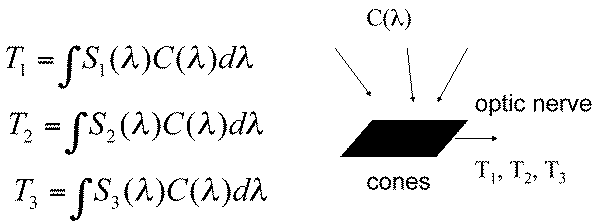
Three Color Theory
- Any two colors with the same tristimulus values are perceived to be identical
- Thus a display (CRT, LCD, film) must only produce the correct tristimulus values to match a color
- Is this possible? Not always
- Different primaries (different sensitivity curves) in different systems
The Problem
- The sensitivity curves of the human are not the same as those of physical devices
- Human: curves centered in blue, green, and green-yellow
- CRT: RGB
- Print media: CMY or CMYK
- Which colors can we match and, if we cannot match, how close can we come?
Representing Colors
- Consider a color C(
 )
) - It generates tristimulus values T1, T2, T3
- Write C = (T1R + T2G + T3B )
- Conventionally,we assume 0 <= T1, T2, T3 <= 1 because there is a maximum brightness we can produce and energy is nonnegative
- C is a point in the color cube shown below
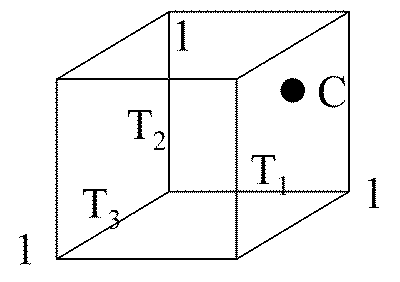
Producing Colors
- Consider a device such as a CRT with RGB primaries and sensitivity curves

- Tristimulus values

Matching
- The above T1, T2,and T3 values are dependent on the particular device
- If we use another device, we will get different values and these values will not match those of the human cone curves
- Need a way of matching and a way of normalizing
Color Systems
- Various color systems are used
- Based on real primaries:
- NTSC RGB (Red-Green-Blue)
- YUV (Addresses human sensitivity to Blue)
- CMYK (Cyan-Magenta-Yellow-Black)
- HLS (Hue-Lightness-Saturation)
- Theoretical
- XYZ
- Prefer to separate brightness (luminance)
from color (chromatic) information
- Reduce to two dimensions
Tristimulus Coordinates
- For any set of primaries, define
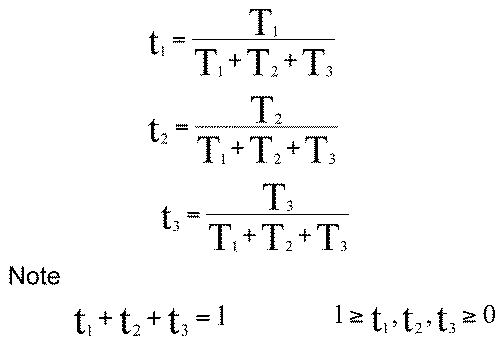
Maxwell Triangle

- Project onto 2D: chromaticity space, solve for t3 only when needed

How HLS relates to Maxwell's Triangle
- Hue - the color name
- Lightness - the color brightness - how far the point is from the origin (black) of the color cube
- Saturation - mix the color with white to form a pastel - how far the point is from the diagonal
NTSC RGB
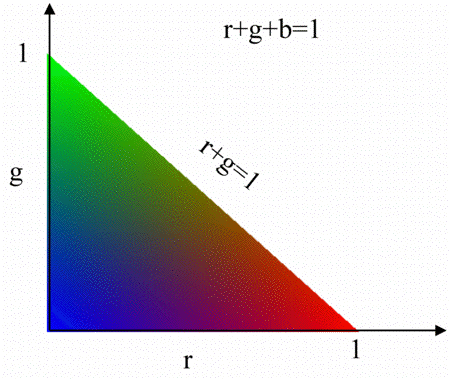
Producing Other Colors
- However, colors producible on one system (its color gamut) are not necessarily producible on any other
- Note that if we produce all the pure spectral colors in the 350-750 nm range, we can produce all others by adding spectral colors
- With real systems (CRT, film), we cannot produce the pure spectral colors
- We can project the color solid of each system into chromaticity space (of some system) to see how close we can get
Color Gamuts
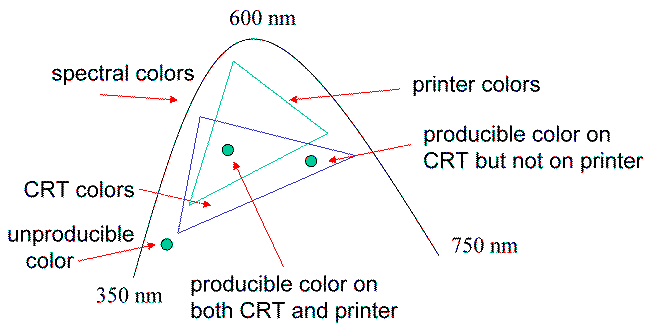
XYZ
- Reference system in which all visible pure spectral colors can be produced
- Theoretical systems
- as there are no corresponding physical
primaries
- Standard reference system
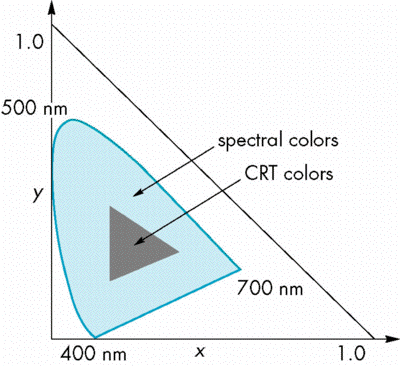
Color Systems
- Most correspond to real primaries
- National Television Systems Committee (NTSC) RGB matches phosphors in CRTs
- Film both additive (RGB) and subtractive (CMY) for positive and negative film
- Print industry CMYK (K = black)
- K used to produce sharp crisp blacks
- Example: ink jet printers
Color Transformations
- Each additive color system is a linear transformation of another
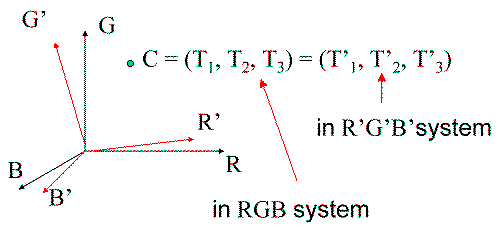
RGB, CMY, CMYK
- Assuming 1 is maximum value of a primary
- C = 1 - R
- M = 1 - G
- Y = 1 - B
- Convert CMY to CMYK by
- K = min(C, M, Y)
- C' = C - K
- M' = M - K
- Y' = Y - K
Color Matrix
- There exists a 3 x 3 matrix to convert from representation in one system to representation in another
- Example: XYZ to NTSC RGB
- find in colormetry references
- Can take a color in XYZ and find out if it is producible by transforming and then checking if resulting tristimulus values lie in (0,1)
YIQ
- NTSC Transmission Colors
- Here Y is the luminance
- Arose from need to separate brightness
from chromatic information in TV broadcasting

- Arose from need to separate brightness
from chromatic information in TV broadcasting
- Note that luminance shows a high green sensitivity
Other Color Systems
- UVW: equal numerical errors are closer to equal perceptual errors
- HLS: perceptual color (hue, saturation,
lightness)
- Polar representation of color space
- Single and double cone versions
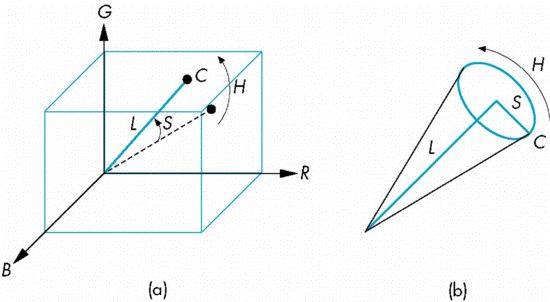
Gamma
- Intensity vs CRT voltage is nonlinear
- I = cV

- I = cV
- Can use a lookup table to correct
- Human brightness response is logarithmic
- Equal steps in gray levels are not perceived equally
- Can use lookup table
- CRTs cannot produce a full black
- Limits contrast ratio
